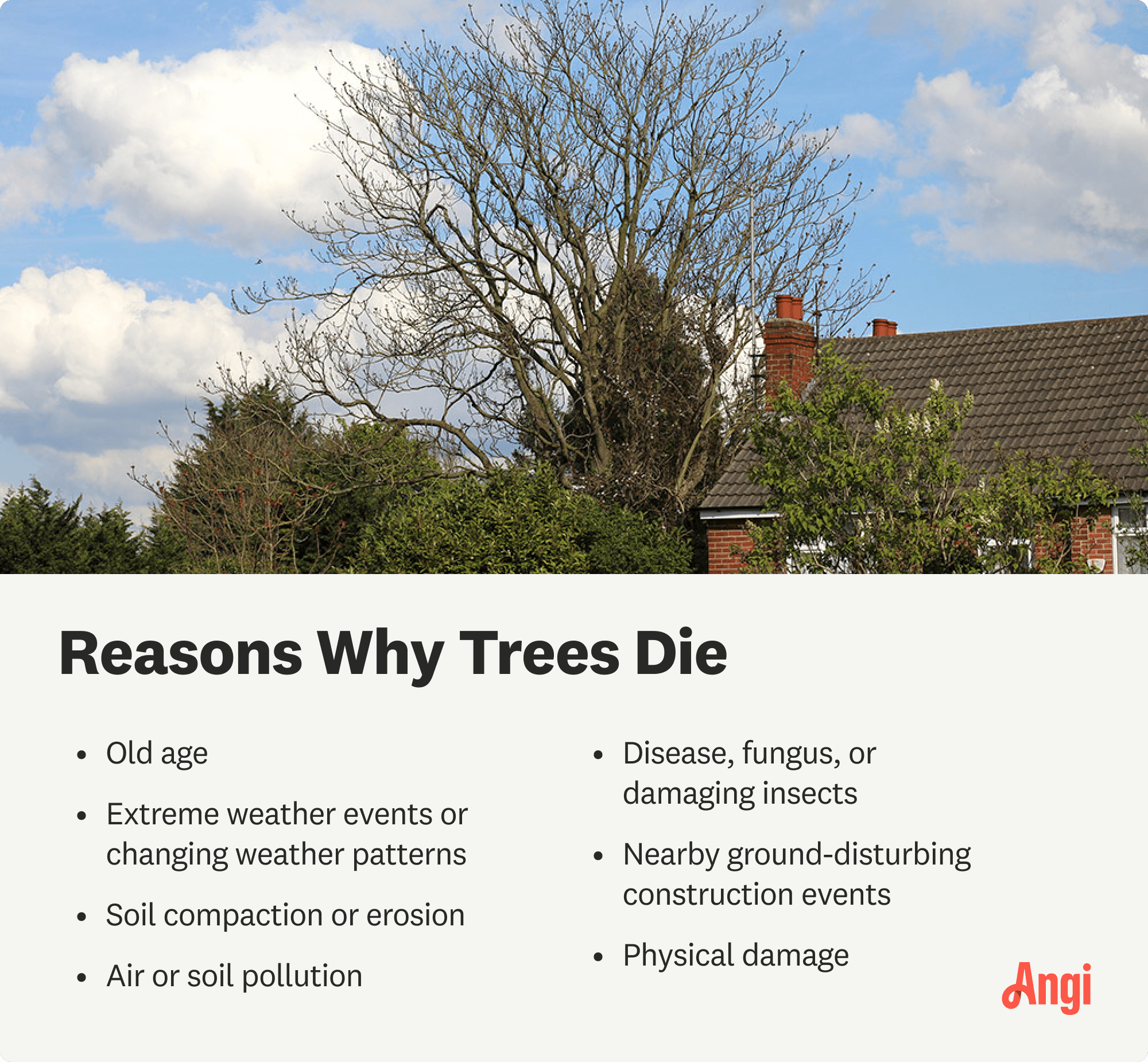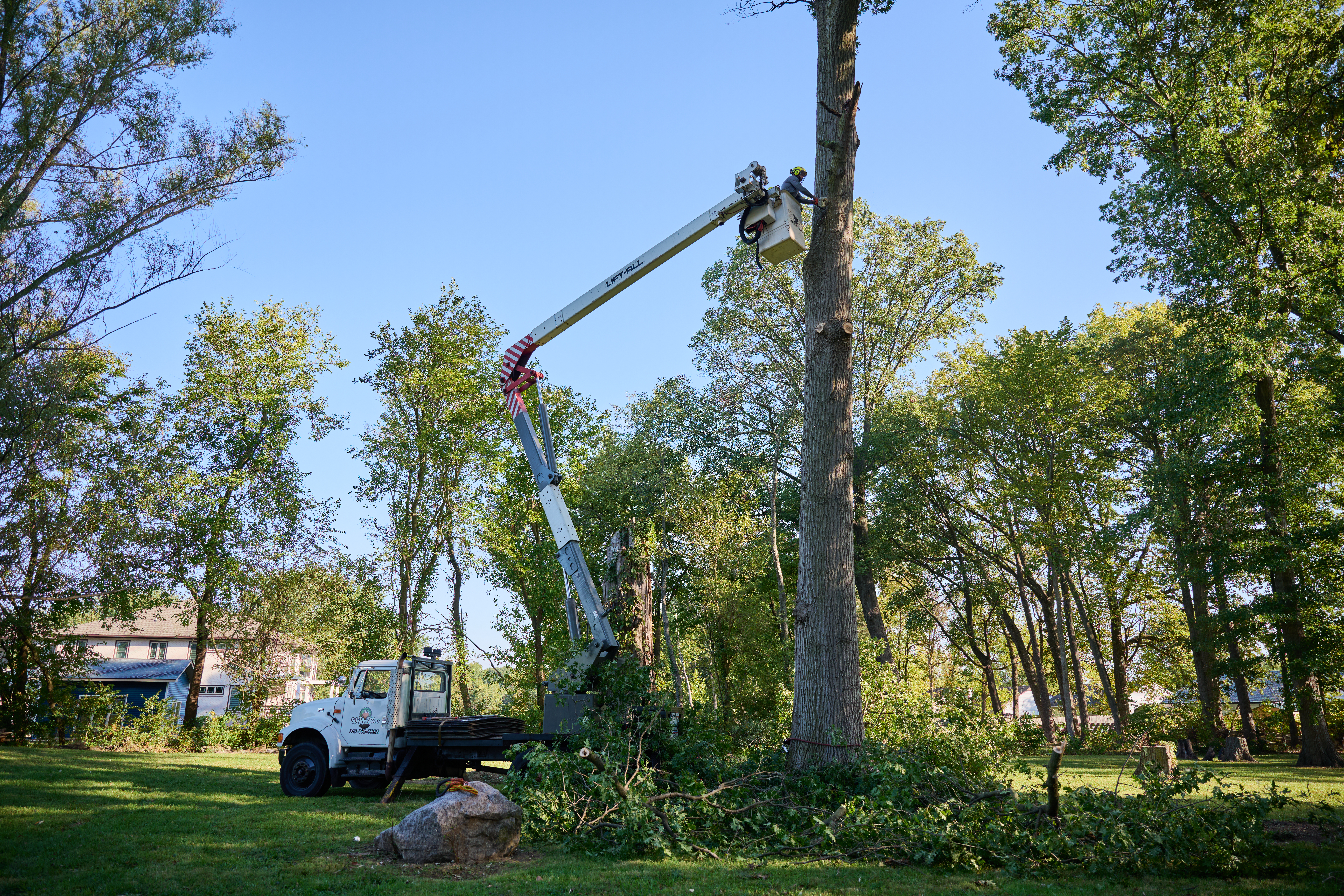
The cost of tree stump removal depends on size, removal method, location, and more. Our guide will show you how much stump removal costs.
Save your tree from pests, diseases, drought, and more


Trees are remarkable: They provide us with food and shade, purify the air, and give us oxygen to breathe. That’s why learning how to save a dying tree is essential to you and the ecosystem. Whether it’s a beloved fruit tree or a large native species that has adorned your yard for years, use these six tips to bring it back to life.

Many things can cause a tree to die, and the first thing you need to do is determine if the tree is actually dying. There are quite a few telltale signs to watch out for, and the faster you address the issue, the better the chance you will have at saving the tree.
These are danger signs of a dying tree, but with the possibility you could save it. Heed these warning signs and hire an arborist to determine next steps.
Exposed roots: Exposed roots often indicate the tree is trying to reach more nutrients or oxygen, or it’s responding to root damage. Exposed roots alone don’t spell doom, but you need to change how it’s watered, fertilized, or protected.
Fungal growth: Patches of fungus aren’t a death sentence, but you should identify and treat it quickly. Some fungal diseases are so dangerous experts may recommend removing the tree.
Minor wounds: Gashes, holes and deep scratches will hurt a tree, but are survivable in most cases. If the wound is limited to one area of the bark and there’s healthy wood and sap around it, the tree will likely recover, but it will be more susceptible to disease and pests.
Discolored or dying leaves: A few discolored leaves or a small section of dying leaves is not a death sentence. However, the tree might need more water or tree disease treatment damage, so inspect it carefully for other signs of stress.
Insect damage: From bark beetles to borers, a variety of insects attack trees. These cause small, identifiable bark wounds in a tree, which are usually survivable. Bad infestations often call for a spray treatment, as well as a tree inspection.
Dying tree limbs: Tree limbs can die off for mild reasons, like windstorms and yard accidents. However, it’s important to keep track of branches that die off—if many in the same spot die, that’s a clear warning sign of a larger problem.
If your tree has the following symptoms, it’s time to start planning its removal. You should hire an arborist to conduct a tree inspection to double-check these grave warning signs:
Rotting or dry wood: If part or all of the tree is rotting, it’s too late to save the tree. This indicates long-term damage that won’t improve, no matter how long the tree hangs on.
Widespread wounds or damage: While trees can recover from small wounds, large wounds or cracks indicate damage it can’t survive. That could happen due to very bad weather, an untreated disease, a construction accident, or similar problems.
Lots of missing bark: If the majority of tree bark starts falling off due to disease, drought, damaged roots or other problems, the tree is unlikely to survive.
Widespread dead limbs: Dead limbs in large sections or on a full side of the tree indicate a serious underlying problem. At this point, the tree isn’t likely to survive, and it’ll become a falling hazard that warrants removal.
Total fallen leaves: Of course, if leaves fall seasonally, that’s not a problem. But if leaves or needles unexpectedly die when they shouldn’t, the tree is on life support.
Severe lean: Leaning trees are caused by serious root damage or rot problems. It’s a classic indication that a tree has died and needs to be removed quickly since it’s a falling hazard.
Small twig growth from dead parts of the tree: If you spot twigs growing from dead spots on the tree, it means the tree has given up on its main trunk and it’s trying to survive another way. These small shoots rarely produce lasting leaves if the tree is too weak.
Trees are very resilient, but if they are over- or under-watered, it can cause them to die. First, you will need to identify whether your tree is dehydrated or overhydrated so you will know how to fix the issue.
If your tree is showing signs of not getting enough water, then you can add a layer of soil at the base of the tree and install a drip line hose for regular watering. Keep in mind that you will need to adjust how often you water depending on how much it rains.
If your tree is showing signs of being overwatered, then you will need to take steps to reduce the amount of water it is getting. In addition to cutting back on how often you water the tree, you may need to tackle issues such as pooling water in your yard, which can be addressed by aerating your yard (be careful not to damage tree roots) or hiring a professional landscaper to grade the lawn for better drainage.

Tree pruning is essential to their growth and health. Pruning can also help treat disease and prevent it from spreading. And proper pruning can reduce the risk of safety hazards and help keep the tree from getting damaged during inclement weather.
However, pruning can damage a tree if not done correctly. If you are inexperienced with tree pruning, consider hiring a professional tree trimming company to do the job for you.
Mulching around a tree can help retain moisture and nourish the soil. But you need to mulch correctly: Adding too much mulch or piling it up around the base of the tree can further harm the tree.
When laying the mulch down, leave about 3 to 6 inches of space around the tree trunk. The mulch should be between 1 to 4 inches deep, depending on the climate and the type of mulch you use.

Before you try treating your dying tree with fertilizer, it’s best to test the soil’s nutrient levels first. This way, you can ensure you apply the correct fertilizer. You need to take precautions when applying fertilizer because it can damage the tree if you do not use it correctly. Too much can actually burn the roots, so you want to make sure you don’t over-fertilize.
Insects and tree diseases, like fire blight disease, can enter a tree through dead, dying, or damaged branches. To prevent the spread of an infestation or disease, you should prune affected branches soon as possible. If there are branches that frequently rub together, prune those that are less desirable, as rubbing can wound a tree and allow pests and diseases in.
Hire a local tree maintenance professional for regular pruning sessions to increase its light penetration and airflow, so fungal infections are kept at bay. If you trim the tree yourself, cut its branches slightly outside the branch collar to allow it to heal more quickly.
If a disease or infestation is present, sanitize your tools between prunings. You can treat a diseased tree with liquid fungicides and pesticides, but treatments must be consistent.
There are certain telltale signs as to whether a tree is in poor health. Aside from these visual cues, you can conduct a scratch test to assess if a tree is still living.
With a small knife, scratch off the top layer of the trunk. If the cambium layer is moist and green, the tree is still alive. If it’s dry, brittle, and brown, it’s likely already dead.

Hiring an arborist near you is the best way to save a dying tree. Arborists are trained professionals who specialize in tree care. You can look for signs of a dying tree, but an arborist can identify the problem and determine if the tree is salvageable or not. Hiring an arborist can save you time, effort, and even protect your other trees from infectious diseases.
The cost will vary significantly depending on the necessary treatment, but it costs between $250 to $2,500 to hire an arborist. You may be able to hire them to consult on how to save a dying tree yourself, but it will depend on the problem and whether you will be able to take on the task or not.
From average costs to expert advice, get all the answers you need to get your job done.

The cost of tree stump removal depends on size, removal method, location, and more. Our guide will show you how much stump removal costs.

The most significant factor in tree removal costs is the amount of debris. Read on to learn more about the average tree debris removal costs.
Get transparent shrub removal cost info. Learn average prices, key cost factors, and tips to save on your next shrub removal project.

Wondering who to call when a tree falls in the road? The answer varies for public and private roads—find out more with this guide.

Grinding a tree stump requires a chainsaw, heavy-duty equipment, and a strategy for cleaning up debris. Keep reading to learn how to use a stump grinder.

Renting a stump grinder is one way to remove stumps in your yard. Find out the average stump grinder rental cost, additional expenses, and more.